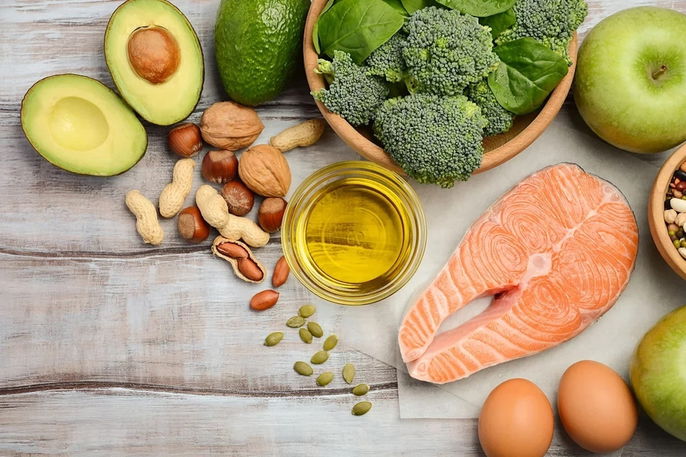Foods that help with acne are those that are rich in fiber (like lettuce, pears, carrots, beans, rolled oats and brown rice), as well as omega-3, zinc and vitamins A, C and E. Foods that these nutrients have antioxidants and anti-inflammatory properties that help to promote healthy skin.
Foods that are high in refined sugars and saturated fats should be avoided, as these foods trigger skin inflammation, sebum production and the appearance of pimples.
In addition changes to dietary habits, it is also important to exercise regularly, as this helps to control blood sugar, hormonal production and reduce skin oil, which is important for preventing and improving the appearance of acne.

Which foods help with acne?
You should include the following foods to help with the appearance of acne and to prevent the formation of new pimples:
1. High-fiber foods
Foods that are high in fiber help regulate blood sugar. Fluctuating blood sugar levels can lead to increased androgen levels, and can also trigger other factors in the body that can worsen acne.
Examples: brown rice, whole wheat pasta, whole wheat bread, quinoa, rolled oats, wheat bran, oat bran, rye flour, whole grain crackers, seeds (chia, pumpkin and sunflower), lentils, beans, chickpeas, soybeans, nuts, fruits and vegetables in general. Check out a complete list of high-fiber foods that you can include in your diet.
2. Omega 3 and healthy fats
Omega 3, particularly DHA, is a type of monounsaturated fat that helps to make up skin cells. It helps to maintain cell membranes, and keeps the skin healthy, hydrated and supple. In addition, it contains natural anti-inflammatory properties that help reduce skin inflammation and improve acne-related lesions.
Polyunsaturated fats and other monounsaturated fats also have anti-inflammatory properties that help fight acne.
Examples: sardines, tuna, trout, salmon, linseed oil, flax seeds, olive oil, avocado, nuts and oysters. See other omega-3 foods you can add to your diet.
3. Probiotics
Probiotics help maintain the intestinal microbiota, which is important for glucose metabolism and normal insulin levels. They also help to increase the production of fatty acids in the intestines, while its anti-inflammatory properties help to improve and prevent the emergence of acne.
Examples: kombucha, sauerkraut, pickles or kefir. Learn more about other probiotic foods and the benefits they can provide.
4. Water
Water is essential for hydrating the skin and facilitating the healing process. You should aim to drink between 2 to 2.5 liters of water per day. Try these infused water recipes if you have trouble reaching these quantities of water in a day.
5. Foods rich in zinc
Zinc is a mineral with anti-inflammatory and healing properties, which can help to speed up the skin's healing process and prevent blemishes or acne scars from appearing. This mineral can also be taken in the form of supplements, as prescribed by your doctor, to help improve acne.
Examples: tofu, eggs, nuts (such as hazelnuts, walnuts, almonds, peanuts, Brazil nuts, cashews, pistachios), and legumes such as beans. In addition, zinca can be found in chicken, turkey and beef. Be sure to opt for leaner cuts with less visible fat.
6. Foods rich in vitamin A, C and E
Vitamins A, C and E are powerful antioxidants that help keep skin healthy. Vitamin E promotes the integrity of the skin and improves its firmness, helping to improve its healing. Together with vitamin A, it helps regulate skin keratinization, a process that, together with sebaceous hypersecretion, generates acne.
Vitamin C has anti-inflammatory effects on the skin and promotes the healing of wounds caused by acne, in addition to preventing skin hyperpigmentation.
Foods with vitamin A: carrots, papaya, spinach, egg yolks, mango.
Foods with vitamin C and E: lemon, orange, broccoli and avocado.
7. Other foods
Plant-based milks such as almond, hazelnut, oat, coconut and soy milk, can be used to replace milk, as dairy appears to be associated with increased pimple formation.
Foods that cause pimples
Foods that cause pimples are:
- High-sugar foods, such as cake, cookies and desserts
- Low-fiber foods, such as white rice, white bread, skinless potatoes and wheat flour
- Skim or whole milk and dairy products, such as cheese and yogurt with sugar
- Foods rich in saturated fat, such as fatty meats, fried foods, sausages, microwave dinners, nuggets, pizzas, frozen lasagna, sauces, butter and margarine;
- Chocolate.
Excessive intake of sugar, milk , dairy products and low-fiber carbohydrates promote high blood sugar levels. This can lead to higher insulin levels, leading to fluctuating androgen levels and therefore increased sebum production.
Furthermore, the steroid compounds present in milk (androgens) contribute to increased skin oiliness and, consequently, the development of bacteria within the hair follicles.
Meal plan
The following table outlines a 3-day sample meal plan that is aimed at helping acne and improving your skin.
The vegetables and fruits in this meal plan are just an example, and can be adapted depending on the fresh and seasonal local products available.
The amounts included in the menu may vary depending on your age, gender, physical activity level, and your general health status. Ideally, you should consult a registered dietitian for a complete assessment so that you can have a customized eating plan.






























